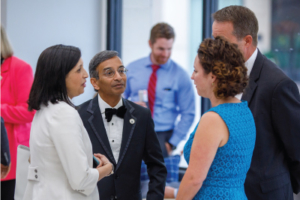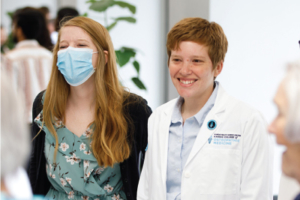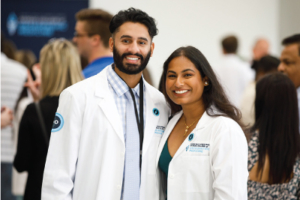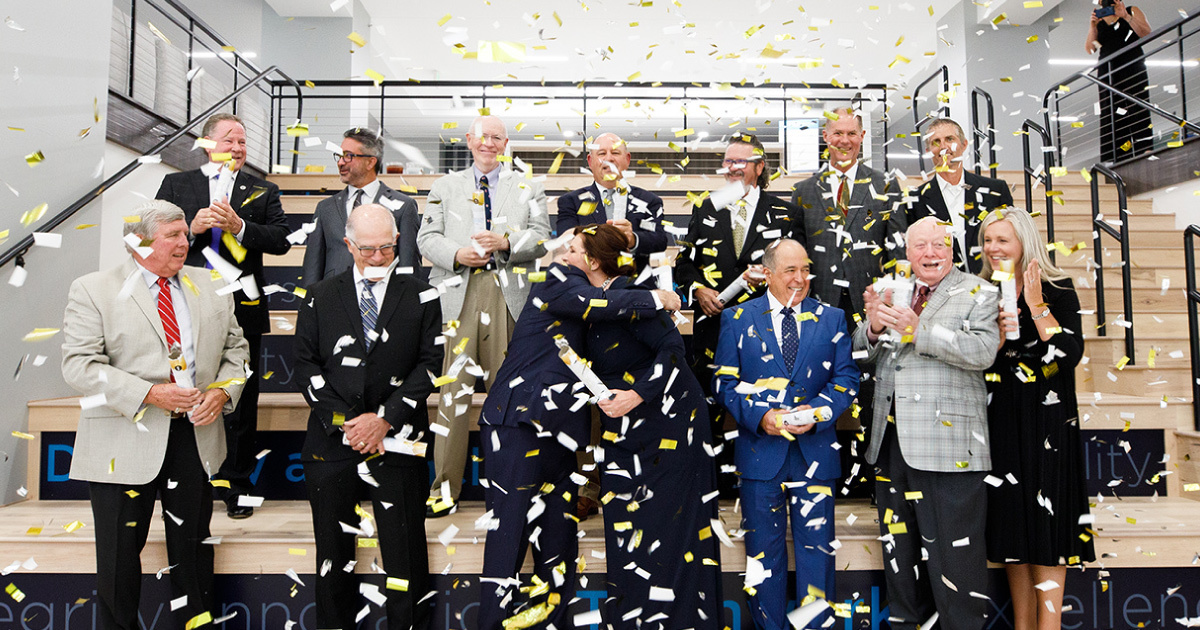The Kansas College of Osteopathic Medicine has opened its doors with the mission of bringing vital health care to where it’s needed most.
After years of planning, building, recruiting an outstanding staff and faculty, and, importantly, enrolling a stellar first class of students, the Kansas College of Osteopathic Medicine (KansasCOM) opened its doors in Wichita, Kansas. More than 300 members of the community attended the ceremony, including President Tiffany Masson, Psy.D.; KansasCOM Board of Trustees Chair Dr. Vadim Levitin; TCS Education System President Michael Horowitz, Ph.D.; U.S. Senator for Kansas Jerry Moran; and Lt. Gov. David Toland.
A vision is realized
 The complexity of standing up a new medical school cannot be overstated. The groundwork for this historic endeavor laid over many years by the Riverside Health Foundation, an organization formed in the last century to support a future osteopathic college in Wichita. That longstanding aspiration was fulfilled through a partnership between KansasCOM and TCS Education System, a higher education nonprofit organization that supports a network of college and universities. As Lt. Gov. Toland said in his remarks to open the ceremony, “There was magic in the culmination of KansasCOM, but there was also a willingness to take a vision and turn it into something real.”
The complexity of standing up a new medical school cannot be overstated. The groundwork for this historic endeavor laid over many years by the Riverside Health Foundation, an organization formed in the last century to support a future osteopathic college in Wichita. That longstanding aspiration was fulfilled through a partnership between KansasCOM and TCS Education System, a higher education nonprofit organization that supports a network of college and universities. As Lt. Gov. Toland said in his remarks to open the ceremony, “There was magic in the culmination of KansasCOM, but there was also a willingness to take a vision and turn it into something real.”
That reality will pay immediate dividends for the city in helping to revitalize downtown Wichita. “Not only will our presence contribute a billion dollars to the state of Kansas over the first 12 years of operation,” Dr. Masson says, “but equally important is that we’re part of this community and helping it to thrive.”
Doctors needed more than ever
As the country’s population ages and we face new medical challenges, the need for physicians will grow. At the same time, projections suggest that the number of available doctors will fall further and further. According to a study for the Association of American Medical Colleges (AAMC) titled The Complexities of Physician Supply and Demand: Projections From 2019 to 2034, the U.S. faces a projected shortage of between 37,800 and 124,000 physicians within 12 years.
and further. According to a study for the Association of American Medical Colleges (AAMC) titled The Complexities of Physician Supply and Demand: Projections From 2019 to 2034, the U.S. faces a projected shortage of between 37,800 and 124,000 physicians within 12 years.
Horowitz emphasizes the urgency posed by this projection. “Our nation is in desperate need of physicians. When TCS set out to build a medical school, we knew we needed a community that could come together to execute a larger vision. We found that in Wichita,” he says.
The location of the college in Kansas is strategic given that this shortage of physicians is most acute in rural areas. A recent article from AAMC details the current imbalances. While 20% of the U.S. population is located in rural settings, only 11% of doctors work in areas of low population and those who do are close to retirement.
Additionally, the article indicates that people who live in rural communities “are more likely to die from health issues like cardiovascular disease, unintentional injury, and chronic lung disease than city dwellers. Rural residents also tend to be diagnosed with cancer at later stages and have worse outcomes.”
The difference KansasCOM is poised to make
Recommendations from the AAMC to solve this staffing crisis include increasing educational opportunities outside of populations centers training more students from rural areas. These suggested steps align perfectly with KansasCOM. Twenty of the 91 students in the KansasCOM class of 2026 are from Kansas, and in 2017, the governor of Kansas commissioned a task force to determine if an osteopathic medical school was needed in the state. ”The answer was an absolute and resending yes,” says Dr. Masson.
 Megan Bayer, MSN, director of simulation at KansasCOM, explains the college’s commitment to the region. “Our students will be involved very early on in going out into the community and learning about what the needs are right here in Wichita and Sedgwick County,” she says. “Part of our goal is to orient them to what services are already available in Wichita [and to] the needs that haven’t been addressed yet. How might our school and our students fill those gaps right here in our community starting on day one?”
Megan Bayer, MSN, director of simulation at KansasCOM, explains the college’s commitment to the region. “Our students will be involved very early on in going out into the community and learning about what the needs are right here in Wichita and Sedgwick County,” she says. “Part of our goal is to orient them to what services are already available in Wichita [and to] the needs that haven’t been addressed yet. How might our school and our students fill those gaps right here in our community starting on day one?”
Placing a college of osteopathic medicine in Wichita provides an additional advantage because osteopathic doctors focus on the whole body and seek to promote wellness. According to the American Osteopathic Association, “From their first days of medical school, DOs are trained to look beyond your symptoms to understand how lifestyle and environmental factors impact your well-being. They practice medicine according to the latest science and technology, but also consider options to complement pharmaceuticals and surgery.”
Innovation in service of human health
Angela Carrick, DO, associate dean of pre-clinical education, explains what this forward-looking approach will mean for the students at KansasCOM. “I think learning to connect with a patient early on is very important,” she says. “It gives our students the opportunity to see them and their families as human, and to really sympathize with what they are going through.”
Key to training doctors to provide health care to underserved communities in a sustainable way is the use of technology. “If we’re thinking about training a physician of the future, we need to be thinking in a very meaningful and mindful way about how we embed technology. Innovation is at our core,” Dr. Masson says. “We’ve always been challenging ourselves to be thinking about how we can rethink medical education. How can we think about this in an innovative way?”
As members of the KansasCOM class of 2026 begin their journeys as health care providers, the full extent of their impact on Wichita and Kansas and the broader community has yet to be felt, but the pieces are in place for the college to effect positive health outcomes for their patients for years to come.

